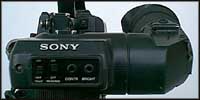Video Camera Viewfinder
This page deals with black and white electronic viewfinders (EVFs), although colour viewfinders work in basically the same way.

Different cameras have various options for adjusting the EVF. Consumer camcorders are usually limited to making focus/sharpness adjustments, whereas professional cameras have numerous options. Work through the following procedures, ignoring the functions which aren't available on your camera.
Some notes on electronic viewfinders:
-
Professional cameras generally use black and white EVFs. Colour EVFs are becoming more popular with consumer camcorders.
-
The EVF is more-or-less WYSIWYG (What You See Is What You Get). This means that if the viewfinder image changes brightness, then the recorded signal changes brightness as well. Once your viewfinder is set up correctly, you can judge your picture quality by what you see (ie. it's not necessary to use the f-stop indicator to see if your exposure is correct).
-
The messages which appear in the viewfinder can give you valuable information. Learn what they all mean.
-
If your viewfinder is fogging up, hold your eye slightly away from the eyepiece. Also, limit your intake of fluids - this reduces perspiration, which is what causes the fogging.
-
Many viewfinder eyepieces can be flipped open, allowing you to stand back from the camera. This can be useful if you have the camera mounted on a tripod, or if more than one person wants to look at the viewfinder. It can also help reduce eye fatigue.
To set the brightness and contrast:
- Switch the camera to colour bars.
- Adjust the viewfinder brightness and contrast until you see a smooth greyscale from peak white to black. You should be able to see a dividing line between each bar.
- Switch the camera to picture.
- Check your exposure on a reliable monitor, either by connecting a cable from the camera output or by doing a test record.
To set the focus/sharpness (diopter adjustment):
The "diopter" is the EVF's eyepiece lens. Adjust this to make the viewfinder image as sharp as possible. This adjustment is usually made either with a ring on the EVF or a sliding button.
- Choose a subject with plenty of contrast - this makes focus easier.
- Zoom out wide and focus the camera lens normally.
- Adjust the diopter until you see the clearest image. If necessary, secure the diopter.
See also: Zebra stripes